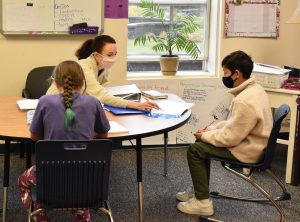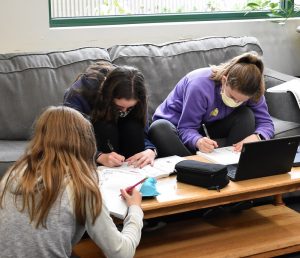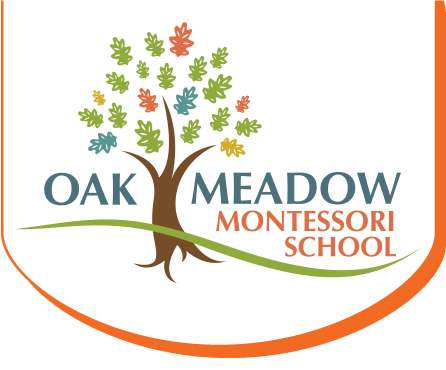Students in Middle School are studying a unit based on the book Omnivore’s Dilemma, which explores the impact of food choices on the environment and animal welfare. Students are seated in small groups around the classroom. As they prepare for an upcoming debate, they are learning how to do research, take notes while reading, credit resources, identify evidence that will best support the position they have taken, and understand the counterarguments against their position. The teacher moves around the class, meeting individually with students. “Where did you get this information? How will you help others understand the source of this data? The more facts you have to back up your argument, the more they will understand your position.” The teacher provides helpful guidance and lets the students work independently.
 In Upper Elementary, two students are seated with the teacher walking through a math lesson aimed at challenging them appropriately. They are looking at two-digit multiplication problems that involve carrying a number to the tens place or possibly the hundreds place. “Looking at this equation can you make a prediction? How will you know when you need to carry a number to the next column?” The teacher illustrates this process in a very tangible and visible way using a math material. She also encourages the students to draw a picture as another option that will help them to better understand the concept.
In Upper Elementary, two students are seated with the teacher walking through a math lesson aimed at challenging them appropriately. They are looking at two-digit multiplication problems that involve carrying a number to the tens place or possibly the hundreds place. “Looking at this equation can you make a prediction? How will you know when you need to carry a number to the next column?” The teacher illustrates this process in a very tangible and visible way using a math material. She also encourages the students to draw a picture as another option that will help them to better understand the concept.
At Oak Meadow, teachers work as guides, providing students with just the right amount of instruction and direction to ensure they are being appropriately challenged at their own place of optimal development. Students are given clear instruction, and then can work at their own pace independently in the classroom, or with a small group.
It’s important to point out that what’s happening at Oak Meadow is not typical in traditional schools or classrooms. In traditional classrooms, the teacher is often at the front of the room, lecturing the whole class, often for the entire class period, and with everyone in the class learning exactly the same thing at the same time.
This week as I visited Middle School and Upper Elementary, I also noticed what the other students were doing while the teacher worked with individuals or with small groups. Although students have a variety of assignments to work on, across all of their subject areas, they are given space and time to plan the work they will complete each day. Each student knows what needs to be done that week, but they plan, manage their time, and use each day to focus on the work they are drawn to complete. Of course the teachers carefully monitor student plans to ensure that everything is getting done.
 In the Middle School great room, students are seated at large tables working independently. I walk around to see what they’re working on — math, science, humanities, even a community service project being organized by the middle school.
In the Middle School great room, students are seated at large tables working independently. I walk around to see what they’re working on — math, science, humanities, even a community service project being organized by the middle school.
I see the same thing when I walk through the Upper Elementary great room. I ask a student to tell me what they’re working on. “We can work on math or humanities or other assignments. In humanities we are studying different countries, and we have access at school to the World Factbook online to gather data. Or we can work on spelling or vocabulary or grammar or the book we are reading in our lit group. We also can get permission from the teacher to take a ‘brain break.’ We use a timer to make sure we don’t take more than 10 or 15 minutes. During a brain break we can do typing or chess or draw or read.”
Of course there are times when the whole class meets as well. Often throughout the day, however, if you enter any classroom at school you will see what I saw today — providing the right balance between personalized instruction and the freedom for students to develop their skills in becoming self-navigating learners and independent thinkers.





